Mint is a versatile and aromatic herb that can be grown easily in pots, making it accessible for gardeners of all skill levels. Whether you’re looking to add a fresh touch to your culinary creations or simply enjoy the fragrant aroma, growing a mint bush in a pot is a rewarding endeavor. However, to achieve a lush and large mint bush, it’s essential to follow specific steps that cater to the plant’s unique needs.
In this guide, we will walk you through the process of growing the largest mint bush possible in a pot. From selecting the right variety to mastering the art of watering and pruning, each step is designed to help you cultivate a thriving mint plant that will be the envy of your gardening friends. Let’s dive in and discover how you can transform a simple pot into a minty oasis.
1. Choosing the Right Mint Variety for Pot Growth
When selecting a mint variety for pot growth, it’s important to consider both the flavor profile and growth habits of the plant. Popular varieties include spearmint, peppermint, and chocolate mint, each offering distinct tastes and aromas. Spearmint is known for its sweet, mild flavor, while peppermint has a stronger, menthol-like taste. Chocolate mint, as the name suggests, has a hint of chocolate aroma, making it a unique addition to your garden.
For pot growth, consider choosing a variety that is known for its vigorous growth and adaptability to container environments. Spearmint is often recommended for beginners due to its hardy nature and ability to thrive in various conditions. Ensure that the variety you choose is suited to your climate and intended use, whether for culinary purposes or as a fragrant ornamental plant.
2. Selecting the Ideal Pot for Your Mint Bush
The pot you choose for your mint bush plays a crucial role in its growth and health. Opt for a pot that is at least 12 inches in diameter and 12 inches deep to provide ample space for the roots to expand. Mint has a tendency to spread rapidly, so a larger pot will help contain its growth while allowing the plant to flourish.
Ensure that the pot has adequate drainage holes to prevent waterlogging, which can lead to root rot. Consider using a pot made of breathable materials such as terracotta or ceramic, which can help regulate soil moisture levels. If you prefer a plastic pot, make sure it is sturdy and UV-resistant to withstand outdoor conditions.
3. Preparing the Perfect Soil Mix
Mint thrives in a well-draining soil mix that retains some moisture without becoming waterlogged. A good soil mix for mint in pots consists of equal parts potting soil, perlite, and compost. The potting soil provides a nutrient-rich base, while perlite improves drainage and aeration. Compost adds organic matter, enhancing the soil’s fertility and moisture retention.
Before planting, ensure that the soil is loose and free of clumps. You can also add a slow-release fertilizer to the soil mix to provide a steady supply of nutrients as the plant grows. This preparation will create an ideal environment for your mint bush to develop strong roots and lush foliage.
4. Planting Your Mint: Step-by-Step Instructions
Start by filling your chosen pot with the prepared soil mix, leaving about an inch of space from the top. Gently remove the mint plant from its nursery container, being careful not to damage the roots. If the roots are tightly bound, gently tease them apart to encourage outward growth.
Place the mint plant in the center of the pot, ensuring that the top of the root ball is level with the soil surface. Fill in around the plant with additional soil mix, pressing lightly to remove air pockets. Water the plant thoroughly to help settle the soil and eliminate any remaining air pockets.
see continuation on next page
